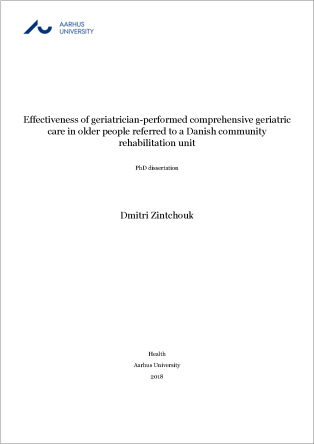Effectiveness of geriatrician-performed comprehensive geriatric care in older people referred to a Danish community rehabilitation unit
Synopsis
ENGLISH SUMMARY
Background: Patients’ length of stay in hospital is declining and therefore rehabilitation of frail older persons must be provided in the community outside hospitals. During the past decades, community-based rehabilitation units in Denmark have offered older persons an opportunity to improve their level of functioning. The goal has been to reduce re-hospitalization and restore functional ability during a 3- to 5-week rehabilitation stay. Data from the National Patient Registry in older adults referred to a community rehabilitation unit in Denmark showed a significant number of hospital admissions and emergency department (ED) visits within 3 months of start of the rehabilitation stay. Suboptimally treated subacute medical conditions and inappropriate medication may result in visits to the ED or re-hospitalization. An integrated model of care such as comprehensive geriatric assessment (CGA) can address and prioritize older people’s complex health needs. Core components of CGA include evaluation of functional capacity, fall risk, cognition, polypharmacy, social support, goals of care, and advanced care preferences. The recently suggested concept of comprehensive geriatric care (CGC) covers the combined assessment and interventional follow-up process. However, we do not know whether CGC provided by a geriatrician will make standard rehabilitation more effective and reduce hospital contacts.
Aim: The aim of this randomized controlled trial was to examine the effectiveness of geriatrician-performed CGC in older people referred to a non-hospital-based rehabilitation unit. We wanted to examine whether it was possible: (1) to reduce hospital admissions and ED visits without increasing mortality and institutionalization; (2) to optimize medication use and to increase functional ability as well as quality of life.
Methods: The 368 participants were 65 years of age or older and were referred to two Danish community-based
rehabilitation units from home or hospital. The exclusion criteria were assessment by a geriatrician during the past
month or receiving palliative care. The intervention was CGC performed by a geriatrician in collaboration with the staff of the rehabilitation units. The medication adjustment based on clinical judgment was the key element of the geriatric intervention. The control group received standard rehabilitation with GPs as back-up. The primary outcome was the number of hospital admissions and ED visits in the first 90 days following admission to the rehabilitation units. The secondary outcomes included the number of days spent in hospital, number of ambulatory contacts, number of GP contacts, medication use, cognitive function, activity of daily living (ADL) function, overall quality of life, residential status, and mortality.
Results: No difference in the number of hospital admissions and ED visits was found. The number of days in hospital, ambulatory contacts, and out-of-hour GP visits or phone calls did not differ between the groups. The number of daytime GP consultations and visits or phone and email consultations was lower in the Intervention group compared to the Control group. Use of day-time GP services was lower in the Intervention group during the rehabilitation stay, but not afterwards. Institutionalization and mortality rates were similar in the two groups. The intervention reduced the prevalence of hyperpolypharmacy (≥10 regular medications prescribed concurrently) and the use of proton pump inhibitors, loop diuretics, and anti-asthmatic inhalers. No difference between the groups regarding changes of cognitive function and ADL function was found. More participants in the Intervention group than in the Control group improved their overall quality of life during the 90-day follow-up.
Conclusions: The geriatrician-performed CGC did not reduce the number of hospital admissions and ED visits during the 90-day period after the participants initiated their individualized rehabilitation stay. No effect was found with regard to the number of days in hospital, ambulatory contacts, institutionalization, and mortality. The observed effect in the form of a reduction in the total number of GP contacts during the rehabilitation stay did not persist. The intervention slightly reduced the hyperpolypharmacy and optimized medication profile. The intervention did not improve cognitive function or ADL function, but seemed to improve overall quality of life during the 90-day followup.
Perspectives: The present PhD project was unable to prove that the presence of a geriatrician providing ‘on site’ medical expertise at a community rehabilitation unit should be standard in Danish healthcare. The target group for CGC may be more selected. A future long-term follow-up RCT evaluating CGC performed by a geriatrician or a primary care physician with an interest in older people in a community-based rehabilitation unit should include frailty assessment at baseline or a validated frailty index as part of the inclusion criteria. A pragmatic approach to target the study population could be to focus on functionally impaired older people with hyperpolypharmacy.

